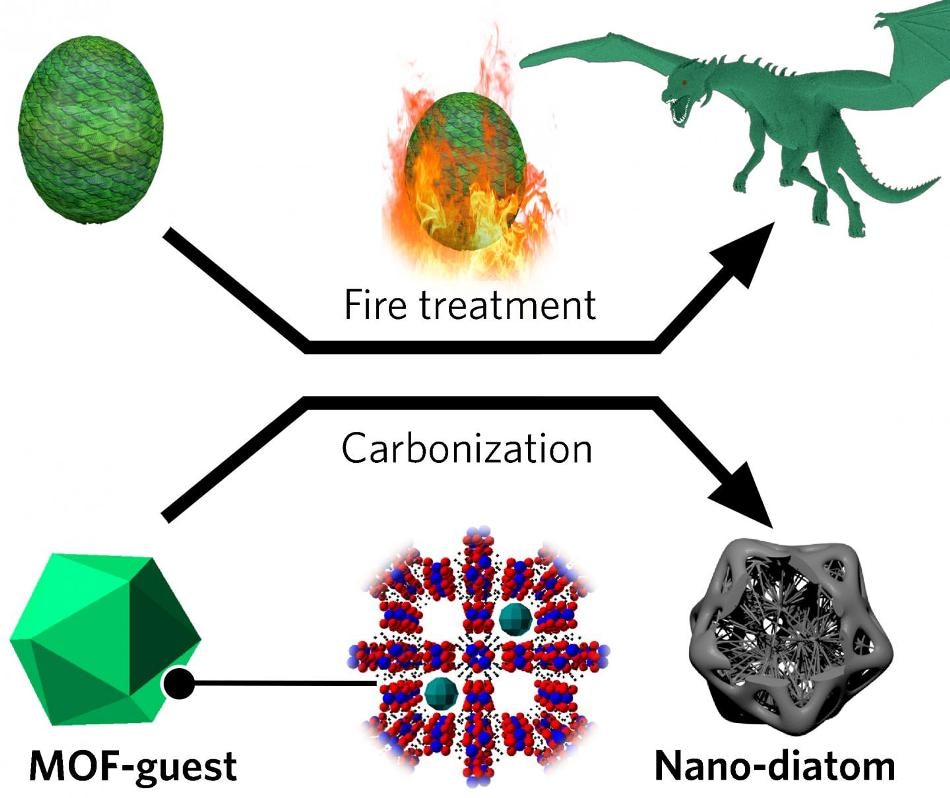May 21 2018
Scientists have discovered that the performance of batteries can be drastically improved with just a pinch of salt. The study involved a team of researchers from Queen Mary University of London, Max Planck Institute for Solid State Research, and the University of Cambridge.
 The transformation of the MOF into a nano-diatom is much like the metamorphosis of a dragon egg into a fire-born dragon when given fire treatment in Game of Thrones. (Image credit: Dr Jingwei Hou)
The transformation of the MOF into a nano-diatom is much like the metamorphosis of a dragon egg into a fire-born dragon when given fire treatment in Game of Thrones. (Image credit: Dr Jingwei Hou)
The researchers discovered that when salt is added to the inside of a supermolecular sponge and baked at a high temperature, the sponge is transformed into a carbon-based structure. Incredibly, they found that the salt reacted with the supermolecular sponge in unique ways and transformed it from a homogeneous mass to a complex structure with struts, fibers, webs, and pillars. While this type of 3D hierarchically organized carbon structure has shown to be extremely challenging to grow in a laboratory, it is essential in providing unrestricted ion transport to a battery’s active sites.
The researchers reported their study in Journal of the American Chemical Society (JACS), demonstrating that using these materials in Lithium-ion batteries will not only allow the batteries to be charged-up quickly but would also allow them to be at one of the highest capacities.
The scientists have named these structures ‘nano-diatoms’ because of their intricate architecture, and according to them, these structures could even be used in storage and conversion of energy, for instance as electrocatalysts for producing hydrogen.
Like Fire-Born Dragons in Game of Thrones
This metamorphosis only happens when we heat the compounds to 800 degrees centigrade and was as unexpected as hatching fire-born dragons instead of getting baked eggs in the Game of Thrones. It is very satisfying that after the initial surprise, we have also discovered how to control the transformations with chemical composition.
Dr. Stoyan Smoukov, Lead Author & Project Leader from Queen Mary’s School of Engineering & Materials Science
Carbon, such as carbon nanotubes and graphene, is a family of the most flexible materials available in nature. Due to its conductivity and thermal and chemical stability, carbon is used in electronics and catalysis.
Featuring numerous levels of hierarchy, 3D carbon-based nanostructures can retain beneficial physical properties like good electronic conductivity and at the same time can also exhibit exceptional properties. These kinds of 3D carbon-based materials can have high strength per unit weight, enhanced wettability (to ease ion infiltration), and directional pathways for fluid transport. However, making carbon-based multilevel hierarchical structures is very difficult, especially through simple chemical routes. But if such materials are to be made in large amounts for the industry, these hierarchical structures would be beneficial.
Promising Applications
The supermolecular sponge employed in this work is also called a metal organic framework (MOF) material. MOFs are a class of attractive, molecularly designed porous materials that hold many potential applications, for example, storage and separation of gases. Baking the MOFs at a high temperature - or the retention of the high surface area following carbonization - makes them useful as electrode materials for batteries. But to date, carbonizing MOFs has sustained the initial particle structure similar to that of a dense carbon foam. When the researchers added salts to these MOF sponges and carbonized them, they found a range of carbon-based materials having multiple levels of hierarchy.
Dr. R Vasant Kumar, a collaborator on the research from the University of Cambridge, said: “This work pushes the use of the MOFs to a new level. The strategy for structuring carbon materials could be important not only in energy storage but also in energy conversion, and sensing.”
Tiesheng Wang, the lead author from University of Cambridge, commented: “Potentially, we could design nano-diatoms with desired structures and active sites incorporated in the carbon as there are thousands of MOFs and salts for us to select.”
The China Scholarship Council (CSC) and the European Research Council (ERC) funded the study, with support from the UK Centre for Doctoral Training in Sensor Technologies and Applications of the Engineering and Physical Sciences Research Council (EPSRC).